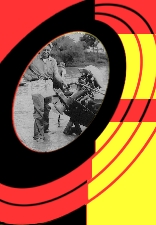 |
 |
Charlie Strang & Manuel Carnakis
The Early Years
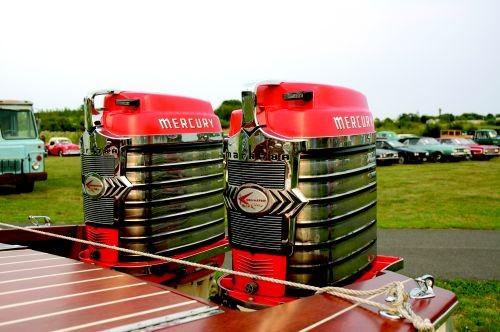 |
Charlie Strang considers himself an outboard motor fanatic since the age of 11, when he attended a New York boat show with his mother and fell in love with a Cyclone race boat that had a racing outboard engine on it. His mother then promised Charlie she would buy him a race boat when he turned 14. He competed in his first outboard race in 1937, as the youngest driver ever entered (at that time) in the Albany-to-New York marathon. His first race ended when his outboard runabout sank after some 60 miles. Charlie won his first boat race when he was 16 and said he still holds the record he established at that particular race.
|
The Educational Years
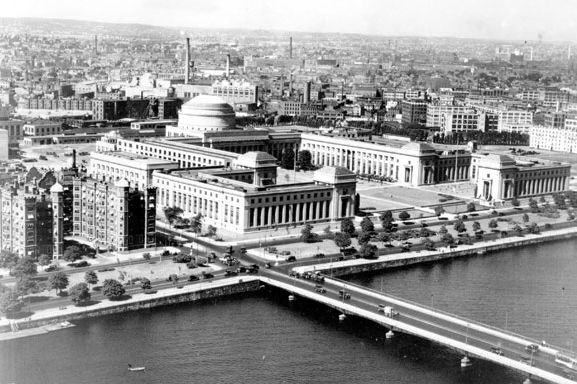 |
Charlie served in the Army Air Corps in World War II and was assigned as a civilian employee to a Government agency working on engine development.
Charlie graduated from the Polytechnic Institute of Brooklyn in 1943 with a degree in mechanical engineering.
Early applications of his talent included experimental testing on aircraft engines for the former Wright Aeronautical Corporation, project research on early jet engines at what is now NASA, and teaching as a member of the mechanical engineering staff at Massachusetts Institute of Technology from 1947 to 1951. Charlie said his area of study was Tribo-physics.
While at MIT, Charlie conducted basic research on the physics of surfaces publishing more than a dozen scientific papers, including one landmark paper on the theory of wear – a paper which is still referenced by current researchers.
|
Charlie meets Carl Kiekhaefer
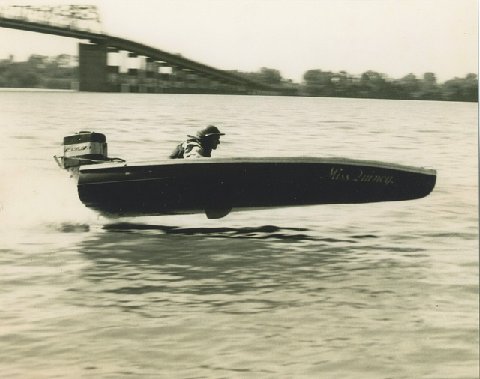 |
Racing eventually led Charlie into the business side of boating after first meeting Carl Kiekhaefer at at the 1949 APBA Nationals in Lake Alfred, FL. Charlie said this was when he also first met O.F. Christner and Eddie Palmer of Quincy Welding, where Quincy Welding's driver, Eddie Palmer, set a record with the Miss Quincy raceboat. Charlie was acting as one of the inspectors at the Lake Alfred races that year. (Photo is of Eddie Palmer testing that Miss Quincy raceboat on the Mississippi River.)
|
The Mercury Outboard Years
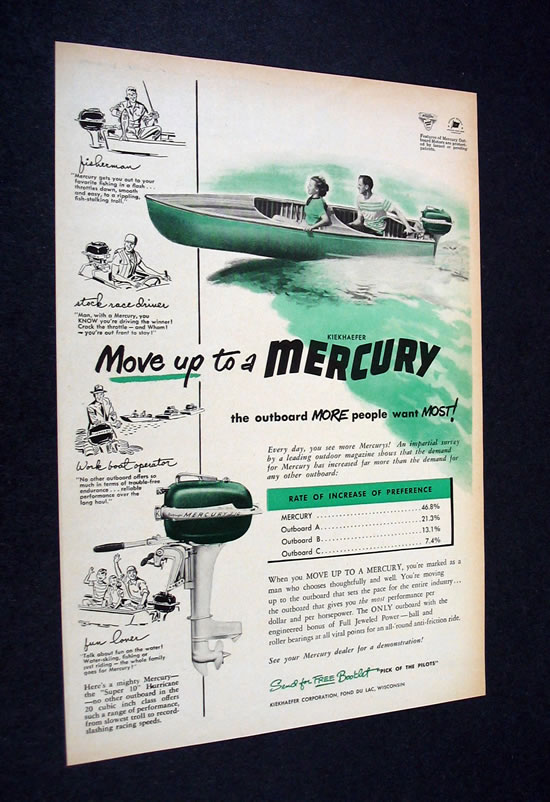 |
Charlie Strang unofficially went to work for Carl Kiekhaefer in December of 1950. Charlie said Carl called him on Christmas Eve and asked Charlie if he wanted to go to work for Carl. Between December of 1950 and June of 1951, Charlie said Carl sent him to Europe to research various manufacturing companies there and their methods of production. Charlie said Carl sent him as he was not known and was better able to do the research Carl wanted without roadblocks.
Charlie "officially" went to work for Mercury Outboard in June of 1951. Charlie said the first job he did for Carl at Mercury was to design an intake manifold for a Chrysler Hemi car that Carl was planning to run in a Pan American race down in Mexico. Charlie said he met Bill France Sr. (Mr. NASCAR) in 1951 at the Pan Am races. Charlie's first offical outboard project for Mercury was making a shifting lower unit for the early green tank Mercs. Charlie also engineered the first internal exhaust deflector to tune the exhaust of the in-line 6 cylinder Mercury outboard.
Although Charlie did not discuss the following story with us, it is well known and documented that in 1951, just 2 weeks after being hired by Carl Kiekhaefer, Charlie presented Carl with an idea he had developed in college about a way to improve the old stern drive technology from the 30’s, which had been tried and abandoned. The truly innovative part of Charlie’s design was to incorporate a double-universal joint between the inboard motor and the outboard propeller, allowing for fluid steering control and maximum power transfer. Carl Kiekhaefer dismissed the idea and instructed Charlie to focus on the Lightning and Thunderbolt engines, letting the modern stern drive concept sit untouched for years. Charlie named his invention after a comic book character, shortening the name to AVC. The AVC drive would eventually become the first functional version of the modern stern drive. Strang and a Kiekhaefer employee named Jim Wynne, Chief Engineer in charge of product testing, discussed the AVC during a business flight in 1955. Wynne included another employee named Alexander into the conversations. Alexander was VP of Engineering for Kiekhaefer at the time. Strang confided that Kiekhaefer had rejected the idea, so the three men decided to pursue it themselves. By 1958, Wynne quit his job with Kiekhaefer Mercury to spearhead the three men’s secret vision by securing a patent in his own name on the AVC and starting up a small company called Hydro Mechanical Development. The three men tried unsuccessfully to sell the idea to other manufacturers. Wynne eventually connected with Volvo and set up a meeting in Sweeden. The meeting went well and Wynne contacted Strang, encouraging him to leave Kiekhaefer Mercury and begin the new relationship with Volvo. Surprisingly, Strang declined and gave Wynne permission to do what he wanted with the stern drive. Volvo agreed to buy the patent. Because Wynne was not as visionary an engineer as Strang, he could not answer questions from Volvo regarding details of the design, so Strang himself had secret meetings with Volvo engineers to refine the product for manufacturing while still at Kiekhaefer Mercury.
Wynne was given credit for the invention and the three shared the secret for 30 years.
OMC, a longtime rival of Kiekhaefer Mercury launched its version of the stern drive in 1961, and to Carl Kiekhaefer’s delight, it had less HP than his existing Mercury 80HP for the same price. As Kiekhaefer observed the competition, he realized that both Volvo and OMC had attached their drive to a standard engine with low HP. Kiekhaefer Marine, with Strang in charge of development, engineered the MerCruiser Stern Drive Power Package, which could be attached to 110-140HP engines for significantly more power. They followed that with the even more powerful MerCruiser II.
|
Carl, Charlie & Cars, Cars, Cars
 |
Charlie said that Carl Kiekhaefer was always a car nut. He loved new cars. (Carl and O.F. Christner had that in common.) Carl insisted that Charlie should be driving a new car every 3 months or so. In 1951, soon after Charlie had moved to WI to go to work for Carl, Carl told Charlie that his Buick was an old ladies car and he needed a new one - so Carl bought Charlie a brand new Olds 88. Charlie said Carl was always telling him that he needed to drive a sexy car. In the 1950's Carl bought Charlie a red Jaguar XK120 convertible. He also gave Charlie 2 airplane tickets so that Charlie and his mother could fly to New York to pick up Charlie's new sportscar and drive it back to Wisconsin.
|
Charlie & Carl's trip to Siesta Key, FL
 |
Charlie said that Carl Kiekhaefer did not like holidays. Charlie remembers one Easter in the early 1950's when Carl told Charlie they were flying to Florida. Carl didn't even give Charlie time to go home and pack a suitcase. Once there, Charlie learned that Carl's trip was to check out land on the south end of Siesta Key, FL (by the city of Sarasota) for a new Mercury wet testing center. Charlie said since neither of them had brought clothes with them, Carl went into a downtown Sarasota store and bought Charlie a pink shirt with black question marks printed all over it. Charlie said Carl told him it was so Charlie would always question things and think.
|
Kiekhaefer and Mercedes?
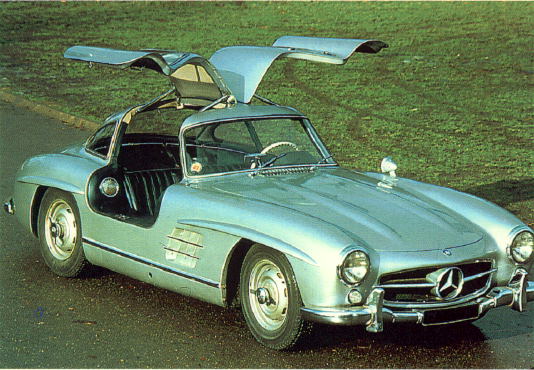 |
Back in the 1950's, Charlie said Mercedes of Germany wanted to buy the Kiekhaefer company from Carl. Mercedes gave Carl a one of a kind, special aluminum body Mercedes Gullwing SL with a specialty motor and Charlie received a white Mercedes Gullwing SL with red leather interior. After a 2 year courtship, Mercedes was ready to come to the United States to open up a factory to build a Jeep but Carl wanted them to manufacture a sports car instead. Negotiations eventually came to a halt and the 2 companies went their separate ways.
|
Charlie, O. F. Christner & Megaphones
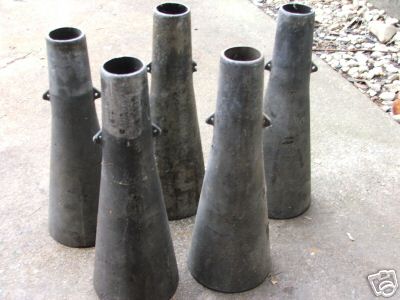 |
Charlie said he laughingly remembers a phone conversation with O.F. Christner in the 1950's regarding Konigs and the upcoming APBA Nationals. The Konig race engines were just coming out with megaphones that helped their power tremendously, something Quincy Welding engines lacked at that time. Charlie remembered that O.F. jokingly said that if Quincy couldn't outrun the Konigs with those "horns," they would have to run into the Konigs and knock those damn horns off to beat them. After the Nationals, Quincy Welding went back to the shop and through R&D came up with their own megaphones, somewhat similar to the Quincy stacks featured in the photo.
|
Why Mercury Motors are painted Black?
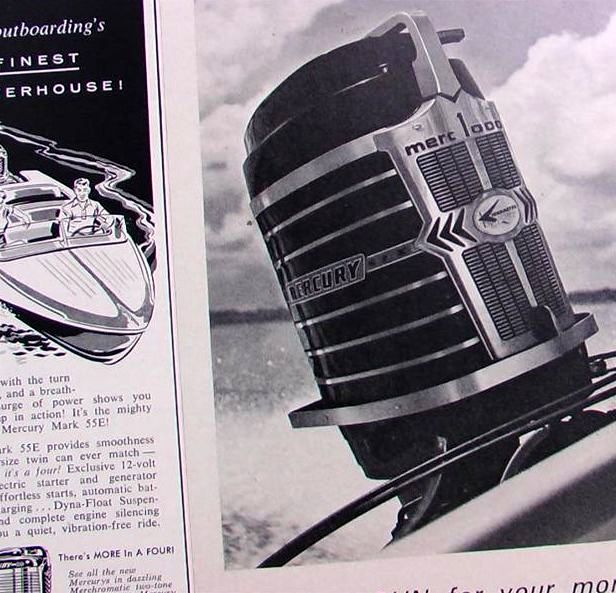 |
Charlie said his mother is the reason why Mercury motors are now painted black. Back when Mercury was coming out with the 1000 Mercury, the prototype paint scheme was a white motor with silver and black trim. Carl Kiekhaefer, when viewing the prototype, thought the motor looked too big and bulky in white. Charlie told his mother about Carl's comments, and Charlie's mother commented back that women sometimes wear black dresses to look a lot slimmer, why not paint the motor black? Carl liked the idea, so Charlie had one of the new Mercs repainted black. Carl loved the slimming effect of the motor in black and ordered the paint scheme to be changed to black for all future Mercury outboard motors.
|
1960's Awards Banquet
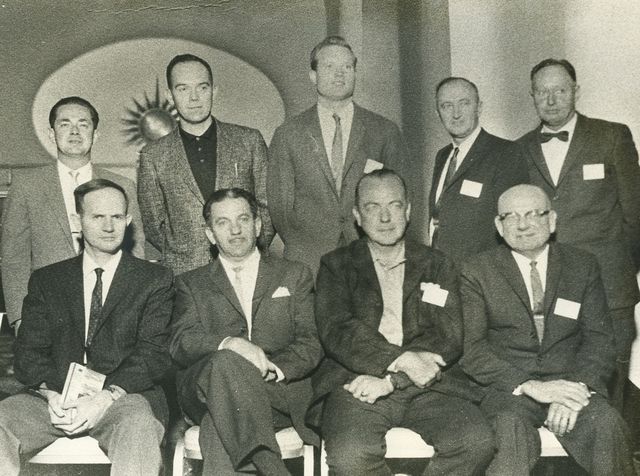 |
Serving as the APBA president from 1963-1964, Charlie’s devotion to the organization helped make it the premier boat racing association in the nation. Similarly, his efforts on behalf of the Union for International Motorboating helped regulate boat sports in 44 nations and earned him UIM’s Medal of Honor.
Charlie Strang also received the American Success Award from President Bush in a White House ceremony in 1989.
The name Charlie Strang is well known among the outboard racing community for his many contributions to the sport. (The photo is from an outboard racing awards banquet - Charlie Strang is in the lower left corner, holding a book. O. F. Christner is in the upper right hand corner, 2nd row.)
|
Vice President of Mercury
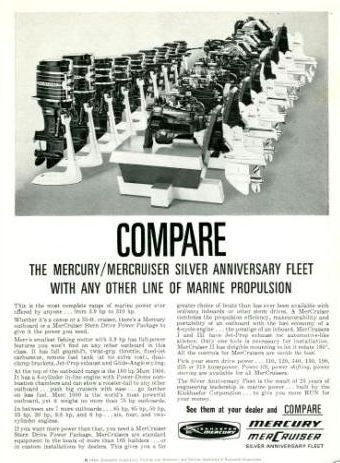 |
Eventually Charlie Strang moved up to Executive Vice President and Engineering Vice President of Mercury Marine. He left Mercury and Kiekhaefer in 1964. Carl Kiekhaefer was forced to resign as President in 1969 and the company name was changed to Mercury Marine, although it was not until 1973 that the Kiekhaefer name was dropped from the Mercury product line.
|
The OMC Years
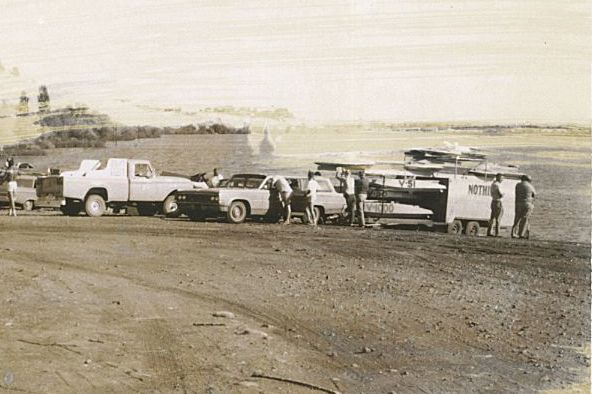 |
In the early 1960's Charlie Strang bought a home in Arizona. While living in Arizona, O. F. Christner and his Quincy Welding racing team stopped in to see Charlie as they were traveling out west to participate in the 1963 NOA Championships at Moses Lake near Spokane, Washington. At that time, Quincy Welding had just finished repainting the racing trailer yellow. Unfortunately, the sign painter did not have enough time to finish the writing on the side of the trailer. When completed, it was supposed to read "Nothing Runs Like a Quincy Merc." The painter had to stop with just the word "Nothing" painted on the side as it was getting dark and the team had to leave town for the long trip. Charlie did not see the trailer in Arizona, but he saw it when he later attended the races in Washington. Charlie thought the "Nothing" was intentional and liked the humor. This photo was taken of the trailer at that nationals at Moses Lake. After two years as a consultant, Charlie Strang joined the Outboard Marine Corporation. He began as director of marine engineering, eventually climbing the corporate ladder to president and general manager in 1974, chief executive officer in 1980, and chairman of the board in 1982. Charlie retired in 1990.
|
Carl Kiekhaufer & Mercury - Beginnings
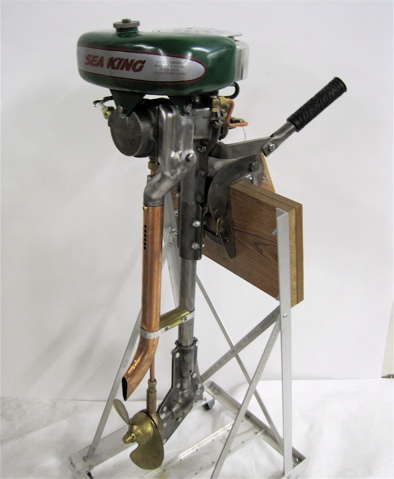 |
Charlie had an interesting story about how Kiekhaefer Mercury Outboard came about. He said Carl told him that he got interested in the Thor manufacturing company not for their outboard motors, but because Thor also had control of a cheese separating machine that Carl was interested in. Charlie said Carl bought Thor to get the cheese separating machine technology, the outboards were an afterthought at the time. Charlie said Carl had a unique talent for knowing what the public wanted, and that talent helped make Kiekhaefer so successful. Carl told Charlie that the Thor motor had 2 problems - the ignition and marketing. Carl set out to fix both issues and, in the process, created one of the great manufacturing companies of our time. (Note: The photo is of a 1939 Sea King 1.5 hp, one cylinder, 2 cycle motor manufactured by Thor for Montgomery Ward.)
|
|
|
